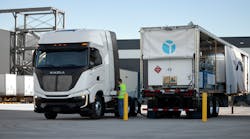The PC-11 heavy duty engine oil category will be a major step forward in engine technology, providing greater protection while also offering efficiency gains and reductions in emissions. Driven by changes in environmental policy and the need to support the rapid development of heavy duty vehicle technology, the new specifications will see North America set a new standard for diesel engine lubricants.
With PC-11 oils set to be introduced to the market this December, it is essential that fleets understand how the new specifications will impact their business, says Brian Humphrey, OEM technical liaison, HD driveline, Petro-Canada Lubricants. He also notes there is still some confusion within the industry. Additionally, fleets need to know the steps that must be taken to be suitably prepared for this major industry overhaul.
Petro-Canada Lubricants (lubricants.petro-canada.com) specializes in products and services to maximize equipment performance, productivity and overall savings. It blends and packages more than 350 different lubricants, specialty fluids and greases that are exported to more than 80 countries on six continents.
Action Items
“PC-11 represents a significant change in specifications that the industry has embraced, and will set a new standard for performance,” Humphrey explains. “PC-11 lubricants will provide greater durability to support engine protection and reduce vehicle downtime – a major source of financial drain in the fleet sector – as well as allow engines to run more efficiently and use less fuel.
“A second phase of the program will be introduced in 2018, with the aim of cutting greenhouse gas emissions by around 1 billion metric tons and lowering fuel costs by $170 billion over the lifetime of the vehicles sold under the program.”
Petro-Canada Lubricants has launched its own campaign, Here Comes the Future (herecomespc11.com), to address common questions asked by fleets about the introduction of PC-11 and how it will affect their business.
The Right Specification
The PC-11 category will include two sub-categories of motor oils – API (American Petroleum Institute) CK-4 and FA-4 – and “it is crucial that fleets understand which oils will be most suitable for their vehicles,” says Humphrey.
API CK-4 will offer full backwards compatibility to previous diesel categories, allowing use in older diesel engine vehicles and offering increased performance and protection gains, as well as the capability of extending the intervals required between oils changes.
API FA-4 is specifically designed for certain newer vehicles. FA-4 oils will have a lower viscosity, meaning less viscous drag in the engine and a potential reduction in fuel consumption while still offering improved levels of wear protection.
Some future heavy duty vehicles will be designed to comply with this specification to offer even higher levels of efficiency, he notes.
Humphrey advises that fleets consult with their engine OEM for specific guidance regarding the recommended viscosity grade for their engines and which sub-category of PC-11 motor oils will be best suited for their applications. This can depend on a wide range of factors, so “gaining their expert knowledge is crucial to unlocking the potential of PC-11 oils.”
Business Impact
The impact of the introduction of PC-11 specifications will vary depending on the size and type of the fleet.
Many fleets are comprised of a range of models of varying ages, observes Humphrey, so there may not be a uniform oil solution for all vehicles. Fleets will need to “understand the best solutions across their operations to witness the true benefit of the new specifications.
“While multiple solutions may be required, upgrading oils can be achieved at relatively low cost and in a short timeframe, offering greater fuel efficiency and providing a faster return on investment than purchasing new vehicles.”
Furthermore, he notes that since FA-4 category oils have been specially designed to cope with the pressures of hotter-burning, more fuel efficient and low emissions diesel engines currently in development, this category is less likely to have an immediate impact on the majority of fleets. However, for those planning to overhaul their fleet and adopt newer models in coming years, it is important to consider how to maximize return on investment – something that FA-4 certainly will contribute to.
Humphrey recommends that fleets “monitor and regularly analyze used oil to understand the optimal oil drain intervals for their specific vehicles and operating conditions to ensure that peak efficiency is achieved. OEMs will be providing recommendations on operating range for all their engines, but first-hand analysis will offer invaluable insight.”
Time to Prepare
While OEMs are currently working on their own specifications incorporating API CK-4 and FA-4, which will be revealed in the coming months, it is essential that fleet operators begin preparations now to ensure that they are suitably equipped ahead of the December 2016 arrival of the new engine oils, stresses Humphrey.
“This is not only an opportunity to improve the efficiency and carbon footprint of fleets, but also a chance to recognize the potential to cut costs and increase the profitability of fleet operations. As with all business decisions, clear understanding and early adoption of new technologies could result in a genuine competitive edge.”



